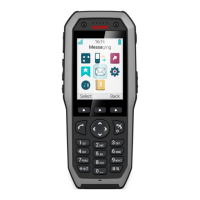CONFIGURATION MANUAL
Ascom d83 DECT Handset
Handset Configuration
By default, when the system profile is activated, its name is displayed in the handset idle screen. The
system profile name replaces the system name (that is, the DECT system the handset is subscribed to). If a
certain system profile always shall be active on a handset, it is recommended to hide the settings and
menus the user cannot change. If the user changes any settings that are specified in the system profile, the
settings are not applied.
Example
In the system profile Alarm has the alarm settings been configured. In this case, the user cannot change any
alarm settings via the handset, despite that the Alarm menu is visible. It is recommended to hide the Alarm
menu to avoid misunderstanding.
1. Select System profiles.
2. In the Active system profile on phone drop-down list, select one of the following:
− Normal - no system profile is used.
− [System profile]
5.45.2.8 System Profile Activation and Deactivation Audible Alert
The administrator may configure the handset to play a sound if the system profile is activated or deactivated.
This provides the user with an audible alert when the system profile changes from inactive to active or vice
versa. The feature can be triggered by several kinds of event, such as moving between different parts of a
buildings where a system profile might be appropriate in one location but not required in another.
To configure the handset to play a sound when a system profile is activated or deactivated, perform the
following steps:
1. Select System profiles.
2. From the System Profile X list select the system profile where the audible alert is to be applied.
3. Set the Activation and deactivation sound parameter to the required customized sound.
5.46 Shortcuts
One click access to predefined functions can be configured for the Soft keys, Hot keys, Navigation keys,
and the Multifunction buttons. For example a soft key can be configured to make a call.
Shortcuts are configured via parameters in the Shortcuts folder.
When programming Soft keys both name and function must be set.
A hot key configured to the Data Send service is also available during the call.
Shortcuts can also be configured via the handset menu. Refer to the User Manual, Ascom d83 DECT
Handset, TD 93434EN.
5.46.1 Restricting Access to Shortcuts
For some application areas, it may be a requirement that the user is prevented from defining shortcuts to
predefined functions via the handset Shortcuts menu. Setting a shortcut to Read only via the WinPDM/
Device Manager enforces this restriction. To access the parameters associated with shortcuts, perform the
following steps:
TD 93426EN / 28 January 2022 / Ver. C
59

